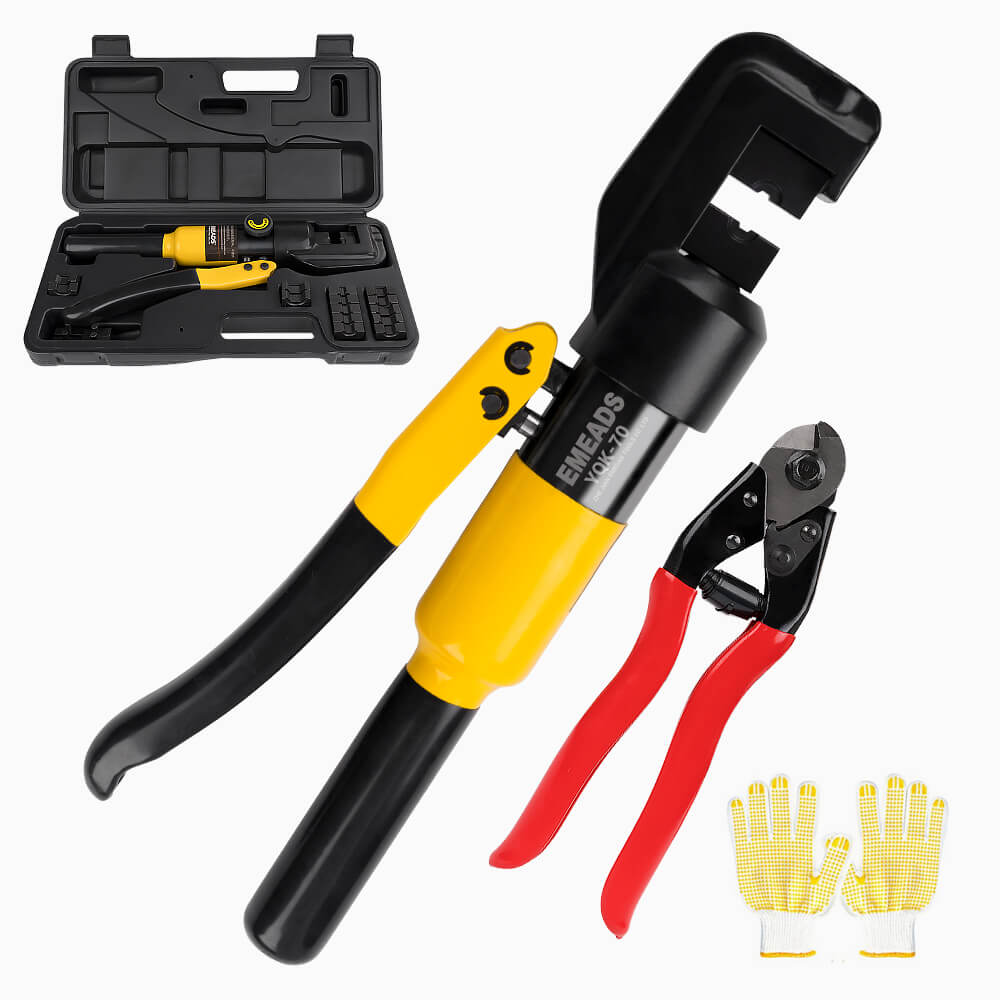- English
- Español
- Português
- русский
- Français
- 日本語
- Deutsch
- tiếng Việt
- Italiano
- Nederlands
- ภาษาไทย
- Polski
- 한국어
- Svenska
- magyar
- Malay
- বাংলা ভাষার
- Dansk
- Suomi
- हिन्दी
- Pilipino
- Türkçe
- Gaeilge
- العربية
- Indonesia
- Norsk
- تمل
- český
- ελληνικά
- український
- Javanese
- فارسی
- தமிழ்
- తెలుగు
- नेपाली
- Burmese
- български
- ລາວ
- Latine
- Қазақша
- Euskal
- Azərbaycan
- Slovenský jazyk
- Македонски
- Lietuvos
- Eesti Keel
- Română
- Slovenski
- मराठी
- Srpski језик
How does a Manual Hydraulic Crimping Tool work?
2024-09-12

How does Manual Hydraulic Crimping Tool work?
Manual Hydraulic Crimping Tool works by applying hydraulic pressure to crimp or press connectors onto the end of a cable. The user places the connector and the cable into the crimping tool and then uses the hydraulic handle to apply pressure to the connector. The hydraulic pressure then compresses the connector onto the cable, creating a secure and long-lasting electrical connection. Manual Hydraulic Crimping Tool is effortless to use and provides consistent and reliable connections.What are the advantages of using Manual Hydraulic Crimping Tool?
Manual Hydraulic Crimping Tool is very easy to use and provides consistent and reliable connections. The tool is portable and doesn't require any external power source. The tool's unique design ensures that the crimping pressure is consistent, reducing the risk of damaging or weakening the connector or cable. Additionally, the Manual Hydraulic Crimping Tool can be used in confined spaces or tight areas, providing greater flexibility in electrical work.What are the different types of connectors that can be crimped with Manual Hydraulic Crimping Tool?
The Manual Hydraulic Crimping Tool can be used to crimp various types of connectors, including butt connectors, spade terminals, ring terminals, and bullet connectors. The tool's versatile design allows electrical workers to crimp connectors of varying sizes and shapes, making it suitable for a wide range of electrical work.How to maintain Manual Hydraulic Crimping Tool?
To ensure that the Manual Hydraulic Crimping Tool works correctly and lasts a long time, it's essential to maintain it correctly. Some maintenance tips include cleaning it regularly and keeping it lubricated, inspecting the tool for any damage after use, storing it in a cool, dry place, and avoiding overworking the tool.Overall, the Manual Hydraulic Crimping Tool is an essential tool for anyone working in the electrical industry. It provides a reliable, safe and consistent method of crimping connectors onto cables, making it an indispensable tool for any electrical worker.
Conclusion
Manual Hydraulic Crimping Tool is a handheld tool used to crimp or compress metallic connectors or terminals onto the end of a cable. It works by using hydraulic pressure to compress the connector onto the cable, creating an electrical connection. The tool offers a wide range of advantages, including portability, ease of use, and versatility. By following proper maintenance techniques, the Manual Hydraulic Crimping Tool can last a long time and provide high-quality connections.Zhejiang Emeads Tools Co.,Ltd. is a company that specializes in manufacturing a wide range of tools, including Manual Hydraulic Crimping Tool. We offer high-quality, durable tools at competitive prices, and our tools are used by professionals worldwide. If you have any inquiries or questions, please contact us at sales@emeads.com.
Research Papers:
1. E. Jensen, (2017), "Crimping Processes and Their Effect on Electrical Connections," IEEE Transactions on Components, Packaging, and Manufacturing Technology, vol. 7, no. 12.
2. G. Ohlsson, (2018), "Investigation of Crimp Connector Electrical Performance," Journal of Electronic Testing, vol. 34, no. 2.
3. L. Zhang, et al., (2019), "Investigation of the Reliability of Crimped Electrical Connections," Microelectronics Reliability, vol. 99.
4. M. Sochan, et al., (2020), "The Influence of Crimping Parameters on the Quality of Electrical Connections," Journal of Electrical Engineering, vol. 71, no. 5.
5. S. Iyer, et al., (2021), "Testing and Analysis of Electrical Connections Made by Crimping," IEEE Transactions on Industrial Electronics, vol. 68, no. 6.
6. T. Maurovic, et al., (2022), "Evaluation of Mechanical Properties of Crimped Electrical Connections," Journal of Materials Engineering and Performance, vol. 31, no. 1.
7. K. Kostov, et al., (2017), "Design and Implementation of a Crimping Tool for Electrical Connectors," Journal of Mechanical Engineering, vol. 63, no. 9.
8. A. Smith, et al., (2018), "Comparison of Different Crimping Techniques for Electrical Connections," IEEE Transactions on Components and Packaging Technologies, vol. 8, no. 2.
9. C. Yu, et al., (2019), "Simulation of Electrical Connections Made by Crimping," International Journal of Advanced Manufacturing Technology, vol. 102, no. 3.
10. J. Kim, et al., (2020), "Comparative Study of Electrical Connections Made by Crimping and Soldering," Journal of Electronic Materials, vol. 49, no. 7.



